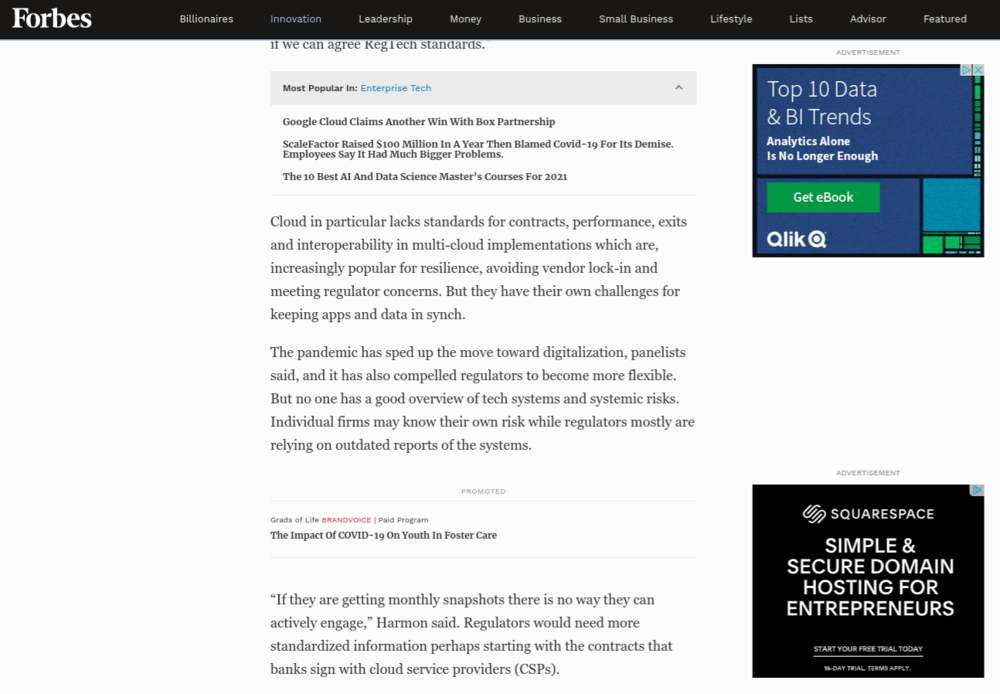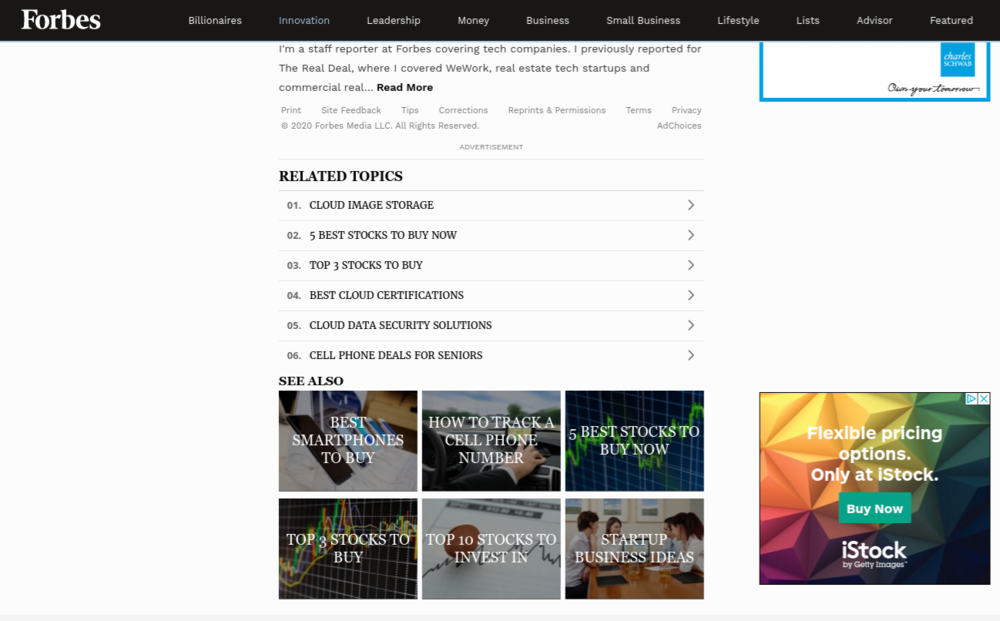Seeing how popular they are online, I figured I’d write yet another blog post about an entrepreneur’s morning routine, small business life, and Squarespace.
Okay, so maybe my version will be a little different. Anyway, I do want to start with my morning reading from a few days ago. I was trying to catch up on some recent cloud technology news….

Can you tell who we use for our domain hosting?
And as I read, I couldn’t help but notice the three ads showing to me next to Tom’s great article. Squarespace really wanted me to sign up for their free trial.

Simple & Secure? Sure, but we can’t accept your free trial because we’ve already been paying you for 6 months.
The end of the article was brought to me by the fourth ad for the same free trial. Did I mention we are already customers? Don’t worry, though. as I scrolled to the next article a new promotion found me:

Can you tell where we source our stock photos and images?

We appreciate your flexible pricing options, iStock: We are already a customer.
Thankfully for iStock & Squarespace’s programmatic media KPI targets, I didn’t need to catch up on any further Forbes news. I closed out the screen.
This trick is one I can play over and over again. It never gets old, and can be done on command. We’ve done it in our webinars using Lucidchart. I could have easily made an example of Insightly, Google Cloud Platform, even Google Ads.
“Are you trying to get practitioners, programmatic media managers or agency directors fired? ”
Quite the opposite. I’m using them as an example because if you are working in programmatic advertising for leading SAAS platforms, DTC Retail, or behemoths like Google, you are the best at what you do.
Even the best practitioners in the industry cannot stop egregious digital media waste in today’s programmatic media ecosystem. Why is this?

The same advertiser showing the same ad to me three times, through three separate ad delivery platforms, with three separate measurements of unique ad exposure, using three copies of my identity
Why wouldn’t the media manager just “exclude converters” from their programmatic media audience list? Nice tip, but solving these issues isn’t that easy.
-
This campaign runs through three separate ad delivery platforms: Amazon, Google & The Trade Desk. Are they being managed from one single DMP? Possibly, but unlikely. Excluding my identity from the Google Ads audience list will do nothing to stop ads from showing from The Trade Desk buy. Amazon’s audience targeting exclusions aren’t helping at all if the Google Ads media is being trafficked directly through the Google Ads platform.
-
Another problem: Even if all of the media were being purchased from a single DMP, and even if my identity as being a subscriber is recorded and excluded from that DMP’s audience list, it wouldn’t have happened. Why? Because each media network wouldn’t know that I’m already a customer – another team member @ Bonsai signed us up for Squarespace from a completely separate device. Squarespace’s first-party identity dataset knows I’m a customer, but there’s no way the third-party audiences used to target these ads know at all.
Tracking Saves The Day? Not So Fast.
https://www.squarespace.com/website-design?channel=display_programmatic&subchannel=amazon&campaign=business-owners_300x250&subcampaign=static-cta1&source=US_Remarketing-7days&utm_source=amazon&utm_medium=display_programmatic&utm_campaign=2020_US_eng_remarketing&utm_term=Remarketing-7days&utm_content=staticWhat is this gobbledygook above? This is a tracking URL from one of those Squarespace ads above. Believe it or not, this string of text gives analytics & reporting platforms useful information on media activity – ad impressions, user clicks, ad sources and more. In theory, this is great for strategists and practitioners. Multiple audience trackers, buying platforms, and media networks can coexist within an integrated digital strategy as long as we are measuring and tracking it correctly, right?
This example URL is exceptionally typical. It could be from one of thousands of digital marketers or companies. Can we find anything amiss or concerning within this tracking URL? Can it solve the media waste problem from above? Let’s break it down.
https://www.squarespace.com/website-design?channel=display_programmatic...Here we see that this ad is part of Squarespace’s “Display Programmatic” marketing channel. Reporting within analytics platforms will indicate any traffic coming from this ad should be attributed to the Display Programmatic channel. Great!
&subchannel=amazonThis particular ad came from Amazon’s ad network, rolling up to the Display Programmatic channel. Ok so far!
&campaign=business-owners_300x250Here we see that this is part of their campaign to reach business owners. I’m a business owner! Still going well! We also see a “300×250” at the end. This…doesn’t describe me. It’s actually the dimensions of the ad that were shown (in pixel size). Hmm, okay. Possibly just a one-off issue….
&subcampaign=static-cta1&source=US_Remarketing-7daysWe see that this particular campaign has “sub”campaigns. This one is “static-cta1” — this is code for “static call-to-action – 1”. Many people would consider this a description of the ad creative itself, so sub-campaign might be a little confusing, but it still could work if that schema was consistent across the organization.
Source is “US_Remarketing-7days”. This is actually information holding what Amazon audience list I am a part of. This means that I am on Amazon’s audience list and remain so long as I have been on Squarespace’s site within the last seven days. I am blogging from our website right now as we speak, so by definition, I will be on this list for seven more days, and as long as I don’t take a hiatus, I will pretty much permanently be on this targeting list.
So, an ad I don’t need to see has the potential to never stop showing to me? This is a problem. Maybe this is the only one? Just fix the remarketing list criteria & logic, and all will be solved? The URL continues…
&utm_source=amazonAmazon? Didn’t we see this already? What’s “utm_source”? Yes, we did see Amazon already, under “subchannel”. This means we track the Amazon ad network characteristic under two different variables, which will confuse someone without institutional knowledge of this particular digital program. It also shows that two different data measurement systems are attempting to deploy overlapping tracking variables in the same tracking URL. What business function benefits from two different measurement systems? Also, why are tracking URLs being deployed in this case — what about a Data Layer?
&utm_medium=display_programmatic&utm_campaign=2020_US_eng_remarketing“Display Programmatic” – another label we’ve seen before with a prior variable name. Even worse, we have another “Campaign” identifier, “utm_campaign”, and this one has a completely different value than the first!
&utm_term=Remarketing-7days&utm_content=staticFinally, we end with “utm_term” and “utm_content” – two new variables with values used prior. UTM parameters, for what it’s worth, are useful for tracking in Google Analytics.
I know there are many veteran practitioners who read through this breakdown and are thinking:
“All of this makes sense, what is the big deal? The first set of parameters sends data to our media buying platform, the second set of parameters collects data for our site analytics tools, everyone knows what these parameters and values mean in our office, what’s the problem?”
— Expert Digital Practitioner
That’s great. How quickly would your digital media directors or executives be able to look at a report built on data collected in that tracking URL above and confidently speak to what they were looking at? How often do you have to correct them on what a “campaign” means to your buying report vs. your analytics report? How long does it take you to train your new operations and analytics teammates to understand your measurement protocols?
This tracking URL chaos looks fine to insiders. To the rest of us, it looks like this:

What mess? I know where everything is in this yard. Things are totally fine.
Spoiler: this measurement framework will not solve a media waste problem. Often, it will introduce so much confusion and complexity that marketers, analysts and executives will spend all of their time and energy simply trying to figure out basic information about the media they have bought. They will never get around to discovering that the remarketing audience lists are flawed, or their first-party datasets aren’t leveraged correctly. There’s pretty much no chance they’ll ever know that half of the customers they targeted on Google are being shown the same ads at the same time through Amazon.
We published our first Marketing Technology Data Proliferation Report this month because we are passionate about data & technology, but hate seeing the waste and risk inherent to our current ecosystem. We’ve analyzed thousands of companies and 30+ verticals. Every industry struggles with technology bloat, feature overlap, customer data and privacy risks, and integration complexities. Yes, these are broad issues that need systemic solutions – but solving these problems will occur the same way every good change occurs that’s worth doing: step by step. In our world, that’s one advertiser, one execution, one strategy at a time.
The real-world implications of marketing technology data proliferation play out in wasted media dollars, annoyed digital consumers, and un-profitable marketing investments every single day. You don’t need to look any further than your morning reading over your next cup of coffee.



